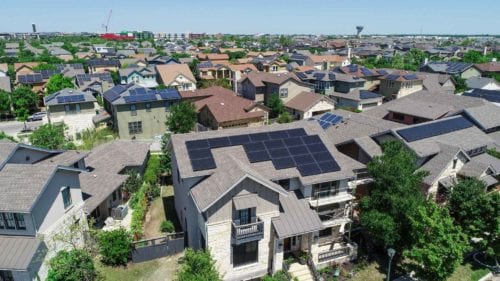
Designing a Climate-Positive Future with Zero-Energy Districts
The environmental impact of buildings is clear. Over the last 30 years the green building industry has emerged in full regalia, with products, rating systems, building science, and architectural élan. Our design and technology have jumped from making buildings perform “better than code” to “zero-energy” or even “net-positive-energy” construction. Today’s high-performance buildings have a much larger role to play in combatting climate change and providing clean electricity, energy storage, and other utility grid services. However, no building is an island, and optimizing an individual building may cause detriment to its neighbors. In some locations, net-zero energy buildings have disrupted utility loads causing increasing amounts of carbon intensive energy to be on the electricity grid. As our understanding of these issues has developed, we are recognizing that there are environmental opportunities that can best be addressed at the urban scale, which is why we’re focusing on net-zero energy districts.
Developments around the world are using urban design to create net-zero energy districts that optimize operational energy and carbon, as well as effectively map water, transportation, and other resources. The opportunities at the district level include energy balancing, economies of scale, optimizing clean mobility, and providing grid services. The opportunities at the district level include energy balancing, economies of scale, optimizing clean mobility, and providing grid services.
Energy Balance Through Diversity
Net-zero energy districts can take advantage of the diversity of supply, loads, and typology for cost-effectively balancing energy demand and supply. This is what is happening at Hazelwood Green, a 180 acre, seven million square-foot mixed use development under construction in Pittsburgh, Pennsylvania. Within the development there will be many building uses, including residential, retail, office, and light industrial. There will be a mix of low rise and high rise, low energy use intensity and high energy use intensity, and various load profiles at different times. Almost all of the buildings will integrate some solar photovoltaic electricity generation capacity. This diversity provides the opportunity to balance energy loads throughout the development by design. When some buildings are generating more energy than they require, the excess can be used by other buildings on the site and vice versa. In this way, the developers can avoid overbuilding the solar resource, and the entire district can achieve zero energy cost-effectively.
Cost-Effectiveness Through Economies of Scale
Net-zero energy districts can also use economies of scale to increase cost-effectiveness. Because of its scale, Hazelwood Green provides opportunities that are not available at the individual building scale. For example, site planning for this development used a “solar envelope” massing approach, which ensured that each block would have access to sunlight and not shade its neighbors. Similarly, the developers proposed a centralized district thermal energy system to provide inexpensive heat to the buildings. These planning opportunities, shared central systems, and opportunity for bulk purchasing are optimized when thinking at the urban scale.
Optimizing Clean Mobility
Working on a district level also allows developers to optimize clean mobility. Near Mumbai, India, the 4500-acre development, Palava, is rapidly being built to zero energy standards. Well-designed low-energy buildings are renewably supplied, but it is the attention to transportation that sets Palava apart. In a typical city of this size, transportation accounts for over half of the energy use, causing congestion, air pollution, carbon emissions, and unnecessary expense. The urban design of this new smart city effectively reduces its transportation carbon footprint to nearly zero. This is done by co-locating business and residential uses to reduce travel distances, and providing pedestrian and bicycle infrastructure to further reduce the need for motorized transit. Electric vehicle charging infrastructure is staged to coordinate with the growth of the city and solar energy supply. Citizens benefit from both the lower mobility operating cost and the quality of clean air.
Supporting the Grid
Net-zero energy districts can provide meaningful amounts of grid services. For example, Peña Station NEXT, outside of Denver, Colorado, is a new 400-acre smart development powered by a solar microgrid in conjunction with a one megawatt/ two MWh lithium-ion battery system. This 100-building district is connected to the local electric grid and provides services including solar to grid integration, ramp control, grid peak demand reduction, and frequency regulation. These valuable grid support services also strengthen grid resilience through backup power and ensure the community is supplied by abundant clean energy. In this district, Xcel Energy was able to avoid the capital cost of building an electrical substation because of the grid support provided by the energy storage system.
Realizing Multiple Benefits
In each of the above developments, multiple benefits are made possible through ideas being developed at a large scale. Using the urban design lens, we can map resources effectively and create smart, connected communities that deliver cleaner air, abundant green energy, enhanced security and resilience, and healthier living conditions.
While many of these ideas are easy to implement with new construction, renovation of our existing communities is critical to creating a climate positive future. There are several examples of communities adopting strategies and technologies to reduce their carbon output, and even transition to become net-zero communities. Arizona State University is currently implementing a “zero-over-time” approach that coordinates building renovations with deep energy efficiency measures. This is also happening in the civic sector—Fort Collins is developing “FortZED,” which is increasing renewable energy production, improving energy efficiency, managing peak energy usage, and reducing greenhouse gas emissions with the Renewable and Distributed Systems Integration (RDSI) project. RDSI reduces peak energy use and integrates renewable energy, such as solar panels, into the city’s electrical energy system.
These projects show how we can use our large-scale district planning to drive toward our broader climate goals. As individual districts begin to reap the benefits of greater resiliency, lower energy costs, and reduced pollution, their efforts are recognized and emulated by their neighbors, creating an interconnected network of high-performance districts. Design of zero-energy districts is a logical, local stepping-stone to meeting our global climate goals.